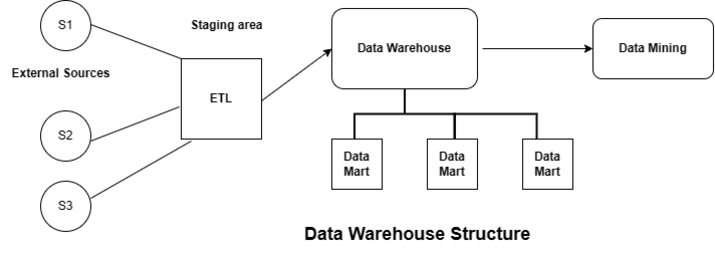
 Data Structure
Data Structure Networking
Networking RDBMS
RDBMS Operating System
Operating System Java
Java MS Excel
MS Excel iOS
iOS HTML
HTML CSS
CSS Android
Android Python
Python C Programming
C Programming C++
C++ C#
C# MongoDB
MongoDB MySQL
MySQL Javascript
Javascript PHP
PHP
- Selected Reading
- UPSC IAS Exams Notes
- Developer's Best Practices
- Questions and Answers
- Effective Resume Writing
- HR Interview Questions
- Computer Glossary
- Who is Who
Data Warehouse versus Views
Although both data warehouses and views are employed in data administration and analysis, they have diverse functions and unique characteristics. The distinctions between data warehouses and views, as well as the optimal times to employ each, will be discussed in this article.
Data Warehouse
The storage and administration of huge amounts of historical, aggregated, and integrated data are the functions of a data warehouse, a large-scale data management system. It is arranged according to subject areas and optimized for reporting and analysis rather than transactional processingDimensional models are a set of models that are utilized to structure data in a data warehouse, making it easy to analyze and query. The data warehouse's metadata explains the origin, organization, and significance of the data.
Data is retrieved from source systems, converted into a usable format, and then fed into the warehouse to build a data warehouse. To maintain its relevance, the data in the warehouse is routinely updated, usually once a day or once a week.
Data warehouses provide access to integrated, consolidated, and historical data, which can enhance corporate intelligence and decision-making. Analysts, data scientists, and other users can analyze data in the warehouse to identify trends and insights that can inform business decisions.

Views
Data from one or more tables in a database are combined to create a sort of virtual table known as a view. Views give users a mechanism to view and alter data without having to create sophisticated queries, which simplifies the process of maintaining and analyzing data. Views can be used to limit access to private information by prohibiting unauthorized users from seeing it.
Views provide customers with a condensed perspective of the data, which helps with data administration and analysis. They are used to query data and generate reports by developers, analysts, and other users. Additionally, views may be employed to streamline complicated searches and connect data from many tables.
Differences between Views and a Data Warehouse
The following are the key distinctions between data warehouses and views ?
Purpose ? Data warehouses are created with the purpose of managing and storing vast amounts of combined, historical, and integrated data that are best suited for reporting and analysis. On the other side, views give users a means to access and change data without having to create complicated queries, which is intended to ease data administration and analysis.
Data Volume ? Data warehouses are made to handle huge amounts of data, usually at the terabyte level. Contrarily, views are employed to access a subset of data from one or more database tables.
Data management ? Data is extracted from source systems, transformed into a format that the data warehouse can utilize, and then loaded into the data warehouse. On the other hand, views are made by merging information from one or more database tables.
Query Complexity ? Data warehouses are built to handle challenging queries and are optimized for reporting and analysis. On the other side, views give users a means to access and change data without having to create complicated queries, which is intended to ease data administration and analysis.
Conclusion
To summarize, data management and analysis are distinct processes that utilize data warehouses and views, respectively. Data warehouses are capable of storing and managing substantial amounts of historical, aggregated, and integrated data, and are particularly useful for reporting and analysis. Interestingly, views give a more straightforward method for getting to and changing information, without requiring complex questions, which can assist with smoothing out information organization and investigation. Data warehouses and views both play important roles in data management and analysis, so choosing which one is best for a given use case is critical.

